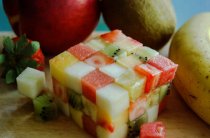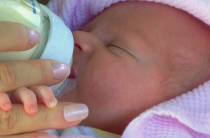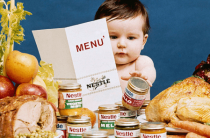A food allergy in children is an acute immune reaction caused by a substance to which the body is sensitive. Children, due to the characteristics of their body, very often suffer from this disorder. In addition, there are a number of factors that stimulate the development of a food intolerance in a baby.
A food allergy in a baby develops due to the fact that his gastrointestinal tract may not be ready to process certain foods. As a result, their components enter the bloodstream insufficiently processed. The baby's body perceives such substances as foreign elements that must be removed as soon as possible. For this reason, specific allergy symptoms develop.
Factors stimulating the development of food allergies in children
Considering the factors that cause this disorder in a child, you can immediately understand what preventive measures are needed for this disease. In some cases, the risk of developing allergies can be significantly reduced if these factors are eliminated from the baby's life.
Reasons for the development of allergies include:
- Heredity of the disease
Modern medicine has proven the fact of a hereditary predisposition to allergies, in particular, its food form. The greatest risk of developing food allergies are children whose father or mother has an allergic status. In this case, it does not matter which form of allergy is present in the family history. In the case of a hereditary variant of the development of the disease, allergic sensitivity and a tendency to develop certain immune reactions are transmitted. Although the risk in children whose parents are allergic is higher than in other babies, this cannot be taken as a fact. There are quite common cases when a father and mother, being both allergic, gave birth to a healthy child.
- Ecological situation
According to scientific statistics, the most common cases of food allergies are found among residents of industrial centers. This is due to the irritating effect of substances that are formed during industrial production on the child's immunity. As a result, it is constantly in an active state, which leads to various immune disorders.
- Lack of breastfeeding
Breast milk is an indispensable natural product that is necessary for the formation of a healthy baby. The mother eats foods, small particles of which pass into breast milk. Thanks to this, the child from the first days also gets used to natural food. As a result of this, children who are breastfed are less prone to allergic reactions when receiving natural products.
- Non-compliance with the rules of natural feeding
Some parents approach the organization of feeding with natural products incorrectly. Remember that for each product there is a time period at which it must be introduced. Moreover, natural food, even if it corresponds to the life of the baby, should be introduced in minimal portions in order to be able to assess the reaction of the baby.
- Gastrointestinal Disorders
The task of the gastrointestinal tract is the full assimilation of food. If a child has those or violations of his work, then this makes it impossible for the full breakdown of food components before entering the bloodstream. As a result, unprocessed components, penetrating into the bloodstream, are perceived by the body as sources of a potential threat. In most cases, disorders such as dysbacteriosis (insufficient population of beneficial microflora) and enzyme deficiency become the cause of the development of children's food allergies.
- Features of the modern food industry
The modern food industry uses a wide variety of ingredients. They are applied everywhere, to give a certain, more attractive color; thickening; enhancing and stabilizing taste, etc. Basically, these are non-natural components that the human body has not yet got used to, because most of them have entered the diet in just the last few decades. They often cause food allergies in adults, and even more so in children. The diet of the baby should consist entirely of natural products, in order to avoid the development of allergic reactions.
- Frequent respiratory viral infections
If the baby often suffers from colds, this can lead to immune disorders. Therefore, in order to avoid the appearance of food allergies, it is worth paying as much attention as possible to the prevention of respiratory viral infections.
- Abuse of hygiene
Perhaps this will seem somewhat strange at first glance, but the unfavorable sanitary situation for the baby is not only the lack of hygiene, but also excessiveness in this matter. Often, caring parents, trying to protect the child from germs, carry out a total sterilization of the home. In this case, a large number of household chemicals and other artificial components are often used. But for the child's body it is extremely important to have constant interaction with stimuli. Thanks to this, the child’s immunity acquires sufficient strength and learns to work correctly. The baby's organism, raised in conditions of excessive sterility, is not able to distinguish friend from foe. As a result, when useful food components enter, a food allergy reaction is formed.
- Mother's failure to follow a special diet
Every mother, before the start of feeding, is required to be introduced to a specialized diet for nursing. As a result, food components that he is not yet able to tolerate normally penetrate into the baby's body. This can happen if the mother eats fried or fatty foods, chocolate, honey, tomatoes, whole milk, and other forbidden foods. Mothers need to take seriously the organization of their diet, while feeding the baby.
Mechanism of development of food allergy in a child
Although the child is born already with an immune system, its formation has not been completed completely. Being in the womb, protected by the placenta, it simply cannot form, because there is not a sufficient degree of threat. Over time, the child's immunity grows stronger. But in the first three years, until its formation is completed, the baby is most vulnerable to food allergens.
In addition, the development of food allergies contribute to the peculiarities of the gastrointestinal tract of the infant. Being in the process of development, it does not yet have a sufficient amount of useful microflora and enzymes secreted for the breakdown of food. As a result, the intestinal mucosa absorbs undigested proteins, to which the human immune system is extremely hostile. The reason is that under normal conditions, the body does not encounter whole food proteins. This occurs as a result of the presence of viruses, bacteria or parasites. Therefore, the child's body reacts extremely sharply to food allergens.
The baby is most sensitive to the following products:
|
|
Manifestations of children's food allergies
Symptoms of a food allergy in a baby can only appear after contact with the allergen. Moreover, due to the peculiarities of the immune response, a reaction to food allergens can develop after a week. Therefore, there are cases when it is impossible to determine the cause of allergic reactions without special diagnostic measures.
Symptoms of food allergies in children include:
- Respiratory system disorders
The baby's respiratory system is highly sensitive to allergens. Therefore, if a food-allergic product is ingested, a child may develop a runny nose, bouts of dry cough, swelling of the nose, leading to difficulty breathing. Attacks of bronchial asthma, which can be found with other types of allergies, practically do not occur within the framework of food allergies. The most dangerous manifestation of this symptomatology in children is laryngeal edema as part of the general allergic reaction "Quincke's edema", as well as spasm of the bronchi and larynx in anaphylactic shock.
- Edema of the mucous membrane of the eyes
The mucous membrane of the eyes also has a developed local immunity, which contributes to the manifestation of allergic reactions in children after they have consumed a product that is an allergen. As a result, the child develops redness of the eyes, as a result of vasodilation. In addition, you can recognize the signs of a food allergy by profuse lacrimation, the child constantly rubs his eyes and squints in bright light.
- Skin manifestations of allergies
With food allergies, the most characteristic symptom is skin manifestations. The child develops inflamed red areas, which then form small and frequent blisters. Bursting, they cover the site of inflammation with a dry yellowish crust. Peeling may occur. Often, skin manifestations are accompanied by severe itching of the damaged areas. Parents may notice that the child begins to comb these areas of the body. In the case of a food allergy in a baby, you can often find symptoms of hives, which are rounded reddenings of a round shape. Urticaria can be represented by both extensive small rashes and large foci.
- Gastrointestinal Disorders
Histamine, which is released by immune cells, can increase the acidity of the gastrointestinal tract during allergic reactions. As a result, the child may suffer from pain, heartburn, stool disorders. Also, during a food allergy, the child often burps. Violation of the gastrointestinal tract can cause a delay in the growth and development of the child. Therefore, they must be eliminated as soon as possible.
Tests to determine food allergies in a child
The specificity of the manifestations of this disease in childhood makes it possible to determine the presence of food allergies already on the basis of symptoms. But in relation to the diagnosis of allergic diseases, this is not enough. It is important to know not only the fact of the presence of an allergy, but also the allergen, which is the direct cause of its occurrence. It is quite simple to prevent the development of symptoms in a baby in this case - it is enough not to eat an allergenic product.
The first diagnostic method that allows you to track the child's reaction to a certain food component is filling out a food diary. A food diary is a detailed description of the foods introduced into the child's diet with a detailed description of the size of their portions, as well as the amount of intake. At the same time, the condition of the baby is also recorded, based on observations. This procedure is carried out within 2-3 weeks. Next, the doctor evaluates the nature of the development of the baby's allergic reaction, based on the data presented in the diary. Based on this method, a list of products under suspicion can be compiled.
An elimination diet can also help in identifying the allergen. To do this, the baby begins nutrition with non-allergenic foods, with a gradual introduction into the diet, which presumably serves as a source of allergies. Initial nutrition is compiled with the obligatory consideration of the child's basic need for calories, nutrients, vitamins and minerals. Only the attending physician can draw up such a diet.
Diagnosis by measuring the level of antibodies
This diagnostic method allows you to determine the degree of allergenicity of certain food components by isolating antibodies to them. Antibodies (immunoglobulins, Ig) are special proteins that signal the immune system about the presence of foreign agents. Their isolation in relation to certain components causes a food allergy in a baby.
In order to determine whether the components of the product are an allergen, solutions of their allergic active substances are mixed with the child's venous blood in a laboratory, then the level of antibodies is observed using diagnostic equipment. Based on the data provided by parents regarding the child's diet, it is possible to narrow down the range of food allergens. This will allow you to quickly and accurately determine the cause of allergic reactions. The use of this diagnostic method does not carry the risk of side effects, which is of great importance in the diagnosis of allergies in babies.
How is a child's food allergy treated?
Due to the early age of the baby, the selection of drugs intended for the treatment of food allergies is carried out with great care. Not all drugs that are well tolerated by adults can be used to treat a baby in early childhood. The most important step is diagnosing the allergen in a child and completely eliminating it from the diet. Measures of drug therapy are designed to eliminate the symptoms, which also cannot be ignored.
- Antihistamines
These substances block the effect of histamine on the receptors of the gastrointestinal tract, respiratory system, eyes and skin. Why is it so important to prevent contact of histamine with sensitive cells. The fact is that antibodies only notify the body of the need to intensively synthesize this hormone. And only after that, histamine, interacting with the cells of sensitive tissues, leads to the development of an allergic reaction. Antihistamines help to force it out of the chain of cellular reactions, thereby preventing the onset of allergy symptoms.
This group of drugs includes such drugs as: diphenhydramine, tavegil, diazolin, erius, cyterizin, pipolfen, astemizole, loratidine, azelastine, etc. The choice of a specific drug is a task that falls solely on the shoulders of the attending physician. It is he who, based on the data of the clinical picture of the disease, is able to determine the most optimal type of drug, its dosage, and whether there is a need to take it at all. The need is understood as a greater benefit from taking the drug than the harm that side effects can cause to the baby.
- Ointments for allergies
Hormonal ointments containing corticosteroids, which are responsible for suppressing immune responses in the body, are extremely effective in treating the skin manifestations of food allergies. However, during food allergies in children, careful selection of these agents is necessary in order to minimize the development of side effects.
Hormonal ointments effectively affect all skin manifestations of allergies: relieve swelling, inflammation, vasodilation, eliminate itching and rashes. Basically, drugs of the first and second class are prescribed, due to the fact that they have the least ability to penetrate into the general bloodstream. This makes them the safest in terms of side effects. These drugs include: prednisolone, hydrocortisone ointment, flucortolone, flumethasone, etc. The use of stronger ointments is justified only in the case of extremely acute and extensive manifestations of skin reactions in children, in the absence of a satisfactory effect from the use of drugs of the first two classes.
For the purpose of healing, moisturizing, as well as protecting the skin, ointments based on pantothenic acid are used. They do not directly affect the immune side of the allergic reaction, however, they are able to alleviate the course of skin manifestations in food allergies.
Gluten as the culprit of food allergies in children
Most allergic reactions in children are associated with the intake of a protein such as gluten. Gluten is a specific large protein that is a structural component of cereals such as rye, wheat, barley and oats. The large size of the molecule means that the child's weak gastrointestinal tract cannot fully process it. As a result, this protein enters the blood without being broken down into amino acids.
- Once in the gastrointestinal tract, the molecule binds with antibodies that provoke the development of an allergic reaction in the child.
- A food allergy to gluten in a baby is manifested by:
- Pain in the lower abdomen, from which the child becomes nervous and whiny, often holding on to the tummy to relieve pain;
- Constant belching of air;
- Stool disorders, which may include constipation, diarrhea, and the presence of undigested fats;
- Excessive accumulation of intestinal gases that provoke bloating;
- A skin rash that can vary in appearance but only occurs after eating gluten-containing foods.
Food allergy to gluten in early childhood is extremely dangerous. It causes serious disorders of the gastrointestinal tract, as a result of which the food components begin to be poorly absorbed. This can lead to growth and developmental delays in the child. For this reason, it is necessary to immediately find out the nature of the allergic reaction and eliminate its cause, as well as the symptoms.















